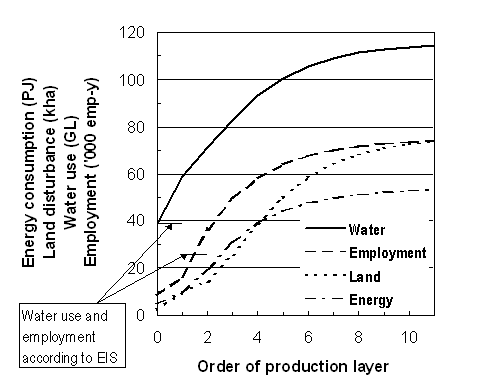Environmental Impact Assessment (EIA) is a process covered by several international standards dictating that as many environmental aspects as possible should be identified in a project appraisal.
While these standards stipulate a broad-ranging study, off-site or indirect impacts are not specifically required for an Environmental Impact Statement (EIS). The reasons for this may relate to the perceived difficulty of measuring off-site impacts, or the assumption that these are a relatively insignificant component of the total impact.
In addition to direct effects, developments cause environmental pressure indirectly through the consumption of goods and services, and the activities of the numerous producing industries in the national as well as foreign economies. Indirect effects are of infinite order: in the case of building an airstrip, for example, they not only include environmental pressure exerted by the airstrip itself (impacts on vegetation, wildlife and the physical environment), but also the land occupied by producers of construction machinery, by steel plants producing the steel for the machinery, by mining operations providing the iron ore for the steel factory, by manufacturers of mining equipment, and so on. These impacts are generally off-site, and may even occur in foreign countries. This process of industrial interdependence proceeds infinitely in an upstream direction, through the whole life cycle of all products, like the branches of an infinite tree.
At the Centre of Integrated Sustainability Analysis we have developed and applied a method that uses calculates the indirect effects of a development proposal in terms of a large range of indicator variables. Using this method, it is straightforward to enhance an existing EIS so that the entire supply chain is covered.
As an example, the results of our case study of a Second Sydney Airport show that the total impacts are considerably higher than the on-site impacts for the indicators land disturbance, greenhouse gas emissions, water use, and employment.

The figure above shows a breakdown of the water used, jobs created, land disturbed, and energy used, directly and indirectly, for the construction of a Second Sydney Airport, broken down by production layer. A production layer is a level of suppliers for a development proposal. The horizontal axis of the diagram below shows these production layers. 0 is the site of the proposal itself, 1 are the direct suppliers, 2 are the suppliers of the suppliers, and so on, covering the supply chain in an upstream direction. The vertical axis shows the impacts associated with these production layers. The impact is shown for each production layer, for example zeroth order is on-site jobs or land disturbance, first order is jobs created and land disturbance caused at the suppliers to the airport construction, second order is the jobs created and land disturbance at the suppliers of the suppliers, and so on.
According to the existing EIS, for example, the number of jobs created directly and indirectly is stated as 25,700, with 8,400 jobs needed directly at the airport construction site, and 17,300 in the region. However, our complete impact assessment shows that in total 75,000 jobs are created on-site and nationwide. Similarly, total water use is about 115 gigalitres (GL), which is significantly higher than the 39 GL (used on-site) stated in the existing EIS.